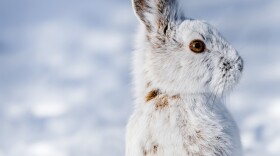Lessons of Curlycup Gumweed
By Cathy Bell Maunu
It’s time for Field Notes, brought to you by the Montana Natural History Center.
To beat the heat on a cool July morning, I headed out for a quick hike through the City of Helena’s natural park on Nob Hill. I paid scant attention to the countless invasive toadflax, mullein, and knapweed that dotted the hillside until my attention was grabbed by an unfamiliar plant nestled amongst them. Intrigued, I dropped to my knees to investigate. Surely it was an invasive, too, reminding me of a young burdock lookalike or even Medusa’s snake-covered head. Numerous curved spikes stuck out from the flower heads in every direction and a copious amount of white goo oozed over them all. Lance-shaped leaves had saw-toothed tips that threatened to poke my nosy fingers. Gummy goo left my fingertips sticky and smelling of resin.
Clueless as to what this was, I relied on a phone app for identification. Curlycup gumweed? Who came up with that creative name? Frederick Pursh, a botanist who cataloged samples from the Lewis and Clark expedition, assigned it. “Curlycup” alludes to the cup-shaped flower head and surrounding curved bracts. “Gumweed” refers to the resin found on the flowers and bracts. Three specimens collected in Nebraska by the expedition in 1804 survive to this day.
Checking the app range map, I noted that gumweed is native throughout the United States in all but the southeastern portion. My impression of it as just another weed evaporated. Here in Montana, Grindelia squarrosa varies in height from one to three feet and grows at elevations between 2,000 and 8,000 feet. It thrives in sunny areas, on roadsides, trails, sidewalk edges, anywhere the soil is dry, rocky, and disturbed. Neglected fields provide ideal growing conditions for gumweed but grazing animals avoid it due to the bitter taste of its resins and its toxic levels of selenium absorbed from the soil.
My curiosity piqued, I turned to my nature journal to record my observations. Why was “invasive” my first impression? Aside from the fact that I found it surrounded by other invasives, it looked like a formidable fortress from top to bottom. A tacky white substance covered the early buds and bracts, creating an effective deterrent against hungry animals and insects. A thick, moisture-retaining skin protected the spiky bracts. Serrated, prickly tips dotted with sticky resin safeguarded the leaves. A thick taproot and deep secondary roots provided strong anchor against wind and weather.
I returned in August to discover the plant had shed its goo and was in full bloom. The intricate spiral pattern of the bright yellow disc florets reminded me of a sunflower, a kindred member of the aster family. These disc florets form a flat, convenient landing pad for bee, butterfly, and moth pollinators.
On one random visit, I spied an almost perfectly camouflaged yellow blister beetle hidden amid the ray florets. I resisted the urge to touch the insect to find out if my blister beetle hunch was correct.
Indigenous peoples have long recognized gumweed for its many healing properties and use it to treat poison ivy, coughs, and stings as well as for a chewing gum substitute. In the not-so-distant past, gumweed was officially recognized in the U.S. Pharmacopoeia for the treatment of fevers, burns, and respiratory illnesses. Presently, gumweed salves and essential oils are sold as herbal remedies.
On my final visit in September, I gathered the prickly and still sticky dried remnants to add to my nature collection. My fingertips retained the pleasant, faint scent of woodsy, sweet incense.
My nature journal pages serve to remind me that in my haste to judge and dismiss a plant as invasive, I may deprive myself of hidden treasures right at my feet. In the case of curlycup gumweed, I slowed down enough for my aversion to transform…into reverence.
Today’s Field Note was written in the Field Notes Writing Workshop at the Montana Natural History Center. This is Cathy Bell Maunu for Field Notes, brought to you by the Montana Natural History Center, providing natural history education for schools and the public throughout Montana. To find out about upcoming events and programs at the Center, call 406.327.0405, or visit our website at MontanaNaturalist.org.





